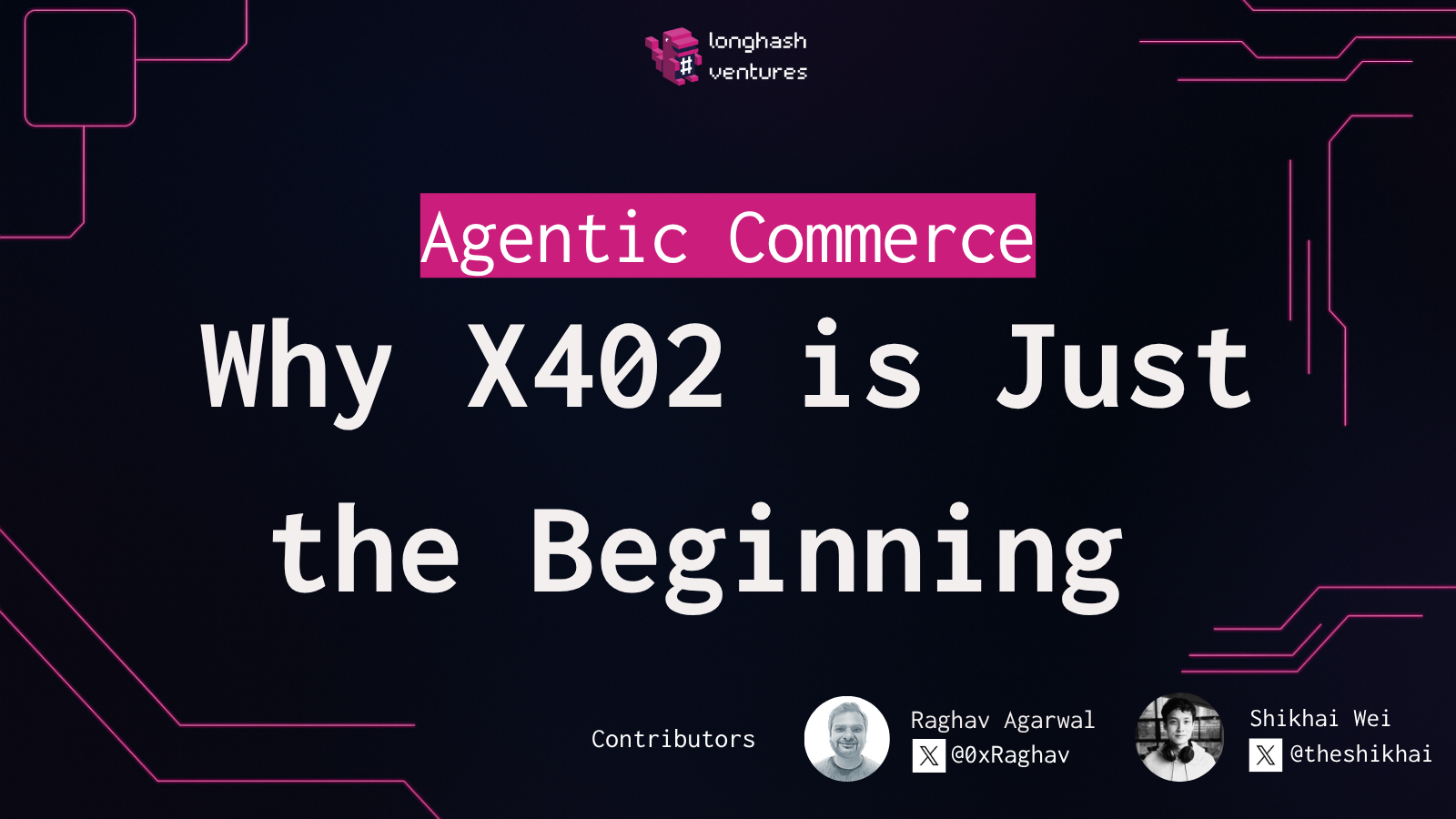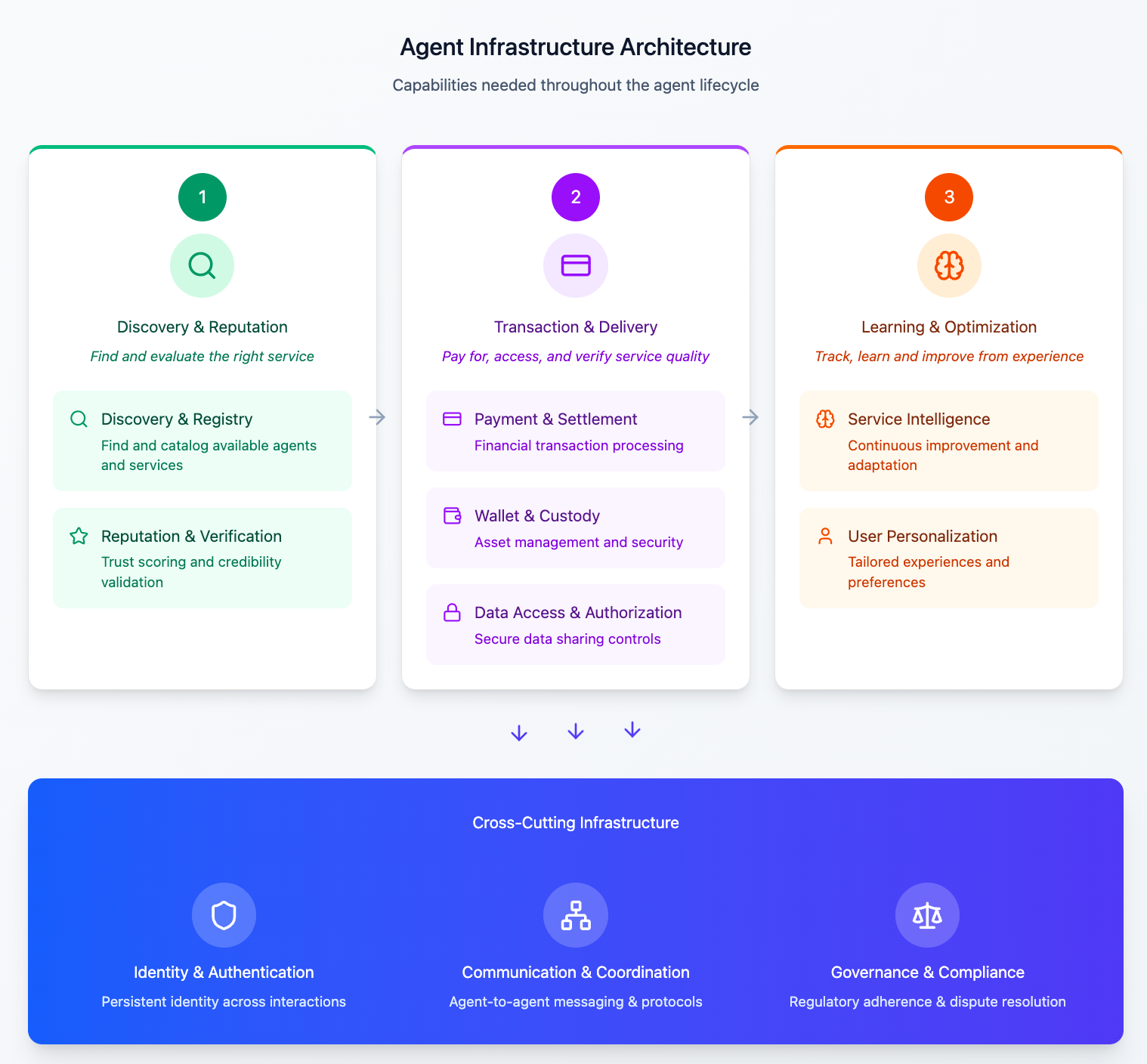
By 2030, AI agents are projected to surpass $1 trillion in US retail transactions alone. Globally, this number can reach $3 to $5 trillion. This isn't a distant future but the agentic economy, where AI agents will handle everything from comparing mortgage rates to negotiating your car purchase, fundamentally reshaping how commerce works. Agents will be able to find, compare, and make purchases for customers. This transition will require a complete overhaul of how businesses operate as agents will be the primary means through which humans interact with the market.
Current businesses are set up to serve the needs of human beings. As we move towards an agentic society, businesses will need to adopt new strategies for discoverability, marketing, monetization, retention and engagement to serve agents acting on behalf of users. The current modern internet economy runs primarily on attention, access, and intermediation.
These models share a common assumption: a human is always in the loop, clicking, subscribing, or authorizing. Agents break this assumption and face many challenges in current set up:
Solving these challenges requires rethinking identity, payments, discovery, reputation and policy at the protocol level. X402, the open payment standard proposed by Coinbase, coupled with blockchain rails solves a part of the problem in the entire value chain.
X402 is an open payment standard which enables AI agents and web services to autonomously pay for digital services (such as data access or API access) in real time without any human intervention. It also enables humans to pay using crypto-rails without going through an onboarding process.
X402 transforms digital commerce by enabling instant, permissionless payments, turning every web service into a pay-per-use utility rather than a subscription or ad-supported platform.
At its core, X402 works through a simple yet elegant request response flow:
X402 remains in its early adoption phase. As per data from X402scan, as of November 2, 2025, $7.04M in total value has flowed through the protocol across 10.63M transactions, an average of $0.66 per transaction. This validates the core micropayment thesis. These are precisely the kinds of small value transactions that traditional payment rails cannot handle economically. Notably, almost 98.5% of this volume has been processed in the last 15 days, reflecting that adoption is still in early stages.

The most prominent use case is data analytics platforms offering their insights programmatically via X402.
AInalyst, an agent launched on Virtuals, integrated X402 to enable programmatic access to its crypto intelligence data and analytics. It has emerged as the top service on X402, processing ~$350K in total value across 493K transactions. Canza, a web3 dashboard and analytics platform featuring customizable widgets and real-time data, has processed ~$215K across 434K transactions. Prixe, a stock price API allowing agents to create financial reports, plus various image and video generation endpoints, was among the first services to integrate X402 and list on X402 Bazaar.
The modest volumes and simple use cases do not fully reflect X402’s true potential. They reflect the missing layers. Without mature identity systems, agents can't build persistent relationships. Without discovery protocols, they can't find services to pay for. Without reputation mechanisms, they can't evaluate which services are worth purchasing. X402 has solved how agents pay, but not yet what they pay for or why.
This is why the full stack matters. Payment infrastructure is necessary but not sufficient. The real unlock comes when identity, discovery, reputation, and governance mature alongside payments, creating a complete commerce environment where agents can operate autonomously and at scale.
To fully realize the vision of an agentic society, we can think of agentic commerce through the lens of the agent lifecycle. When an agent needs to accomplish a task, whether booking travel, analyzing data, or financial planning, it moves through three fundamental stages:

Each stage requires specific technical infrastructure to function effectively. However, some capabilities provide essential support throughout the entire lifecycle. We organize the infrastructure into Core Lifecycle Layers (specific to each stage) and Cross-Cutting Layers (needed across all stages).
These layers are specific to each stage of the agent's journey through commerce.
Before an agent can transact, it must discover available services and evaluate which providers are trustworthy and suitable for its needs.
Once an agent selects a service, it must execute payment, gain authorized access, and verify that the service delivers as promised.
After consuming services, agents accumulate performance data and user preferences to optimize future decisions and build long term value.
This stage encompasses two types of intelligence that agents build over time:
This stage is primarily about data accumulation and algorithmic optimization rather than protocol infrastructure. The value here comes from longitudinal data. Agents that learn become irreplaceable, creating switching costs through accumulated context. We explore this in more detail in the "Learning & Optimization" section of Value Capture in Agentic Commerce.
These layers provide essential capabilities throughout the agent lifecycle, from initial discovery through post transaction learning.
The real question for businesses and investors is: where do defensible business models emerge? Each stage of the agent lifecycle presents distinct opportunities for businesses to capture value, not by controlling the underlying protocols, but by solving the coordination, trust, and optimization problems that emerge at scale. The winners won't be those who simply implement standards or build basic registries. They'll be those who make agent commerce seamless, safe, and continuously improving.
End to End lifecycle
While businesses can capture value at individual stages, the most defensible position may be owning the entire lifecycle. By starting with deep specialization in a specific vertical, a project can also expand across the agent lifecycle, building an end to end ecosystem, capturing more value, and ultimately establishing dominance. Virtuals Protocol has built a society of agents, where agents can operate independently, discover, interact, communicate and negotiate with each other, assign tasks based on certain policies, evaluate the outcome while providing verifiability through on-chain record of agent-to-agent relationships. Virtuals Agent Commerce Protocol has generated over $100K in revenue in just three months since its July 2025 beta launch. Virtuals, however, runs on Base and Solana. Kite AI is attempting to go one step further by building a purpose built Layer 1 for AI combined with cryptographic identity, programmable governance, and native access to stablecoin transactions. Although attracting users and liquidity on a new settlement layer requires significant effort.
While crypto rails provide essential infrastructure for permissionless payments and programmable custody, they're only one piece of the puzzle. The agentic economy requires breakthroughs across multiple dimensions before reaching its trillion-dollar potential.
Model improvements are foundational. OpenAI has emphasized that reducing hallucinations remains stubbornly hard to fully solve. Improving reliability is critical for agents handling real transactions. Beyond accuracy, we need smaller, distilled models that run locally, on devices, at the edge, enabling privacy preserving personalization without sending intimate data to cloud providers. OpenAI’s latest research also shows that “It can be easier for a small model to know its limits.”
Trust infrastructure extends beyond payments. Verification technologies like zkML and TEEs will become essential. Users need cryptographic proof their agent executed intended logic, not a compromised version. Service providers need verifiable guarantees that agents are authorized and compliant. These trust primitives are as important as payment rails for scaling agent commerce safely.
The digital physical bridge unlocks new markets. Robotics and autonomous systems will extend agentic commerce into the physical world. Agents will not only purchase products but coordinate delivery, assembly, and maintenance. Agents will negotiate, transact, and physically move goods end-to-end. This convergence represents the ultimate realization of autonomous commerce.
We're still early, but the direction is clear. Infrastructure is fragmented, standards are nascent, and many problems remain unsolved. Yet crypto's role is inevitable. When agents need to transact globally, instantly, and programmatically across untrusted parties, traditional rails with intermediaries, settlement delays, and geographic restrictions cannot scale. Crypto provides the only architecture matching requirements: permissionless access, instant finality, programmable logic, and global reach.
This creates a rare opportunity to leapfrog. Agentic commerce isn't upgrading existing systems but a new system built from scratch. The winners will be those solving coordination, trust, and optimization challenges that emerge when commerce operates at machine speed and scale.
We'll continue exploring each layer in depth, the challenges, business models, and builders shaping agentic commerce. The race has just begun.